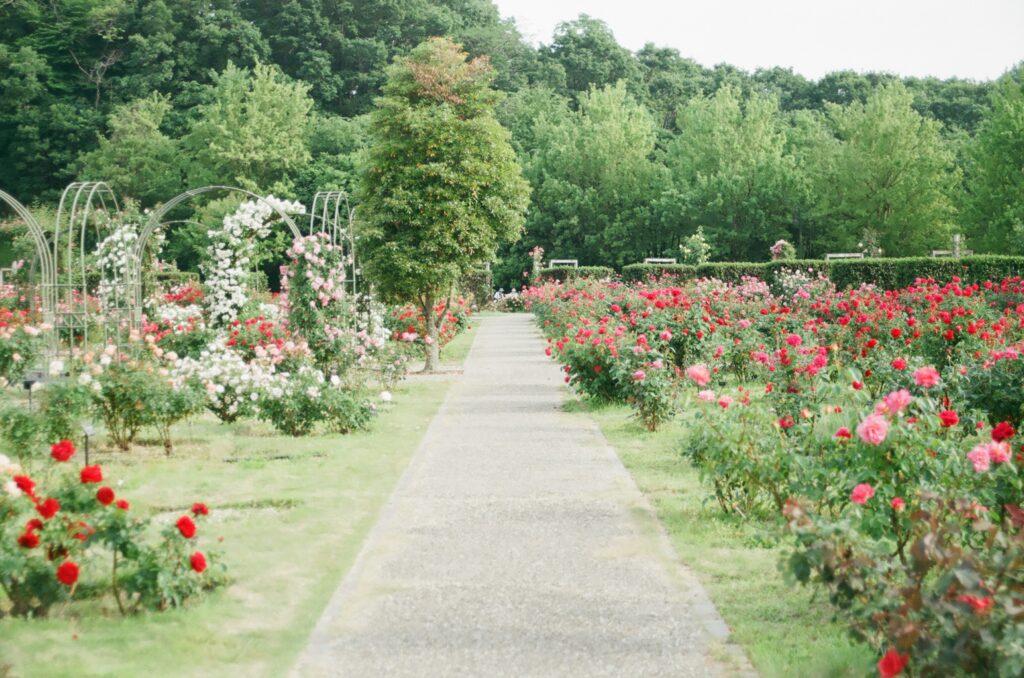All roses require an open, sunny, well drained position, without competition from tree and shrub roots etc. Some shade during the day will still allow some reasonable plants, however full sun is desirable for best growth. In addition, plants are more susceptible to disease problems in shady areas. There are always problems with wind effects from time to time in this area, so some staking particularly of young water shoots will be necessary.
Life is too short to grown any plants including roses, which we do not have some knowledge about. Why waste a year or more finding out by bitter experience? Colour, pest/diseases, growth habit, quality of flowers, does it perform well here on the coast etc? How do we find this out? Talk to other gardeners, visit gardens/flower shows etc. Join a garden club or specialist society. Sources of supply can be; supermarket chains, nurseries, mail order rose specialists. Roses may be bare rooted in a dormant condition, or may be in containers. Rose plants held indoors, in warm store in poor light often produce premature shoots. So it is advisable to buy plants as soon as they are in the stores. Plants with premature shoots should not be purchased, as die back (stem canker) occurs when they are exposed to the elements.
SOILS
Properties close to the coast, usually have well drained soils. Whilst others, more inland may have silty clay soils with poor drainage. There is no mystery about growing roses in this area, but they have requirements like most plants, such as good drainage, good soil with adequate organic matter and an ideal P.H. of about 6.5 to 7. To ensure good drainage, construction of raised beds may be required. Most coastal soils here are acidic. Liming may be necessary. Roses can be grown in beds with other plants, but most serious growers do not. Roses are like shrubs, except that because of the nature of their growth, having relatively shallow root systems, they do not compete for nutrients as well as most shrubs. Existing soil can be improved by incorporating organic matter, such as compost or old manure etc, or by growing green manure crops. Soil can be imported, but there is a risk of nut grass, oxalis etc being present. These soils should be tested for P.H. and texture. A simple test of soil is to shake some up with water in a bottle and observe the results after a settling period of say, a few hours. This will give an indication of the texture (% of sand, silt and clay) Really, it is advisable to get a laboratory test of soils in new gardens, as well as the imported soil. Even experienced gardeners can benefit from these sources of information. Beds should be prepared well in advance of planting.
PLANTING
The distance between plants can cause problems, if overcrowded it is difficult to maintain them and it is said that disease incidence is magnified if plants are close together. Generally one metre apart for most plants is a suitable distance, however, some plants may grow tall and to about 1.5 metres wide. Good rose catalogues usually give some dimension indications, if there is any doubt about their habit. Old garden roses and modern shrub roses may become quite large and may require more room.
With all roses be prepared for some transplanting in time, as some plants may become quite vigorous. Bare rooted plants should be planted straight away when received. Sometimes on the coast, they arrive in stores and nurseries in May. Normally they are planted in June/July. However, early planting does not cause any problems, unless the plants have produced premature growth, which may be affected if frosts occur (some coastal areas of course do experience frosts). Plants from specialist nurseries may arrive as late as August, hopefully still in a dormant state. There are theories about planting shrubs/trees as well as roses. If the soil is well prepared prior to planting, there is no need to provide fertiliser until the plant produces a fair amount of growth. Some people advocate the use of slow release fertilisers at planting time. Normally plants from containers are planted at the same height as in the container.
Roses are one exception. Most Rose plants are propagated by budding, new growth arising from the budded area (the union). This should be set at ground level, this means that container roses should be planted deeper than when in the container, so that the union is set at ground level. The soil is not disturbed when planting from containers, apart from minor teasing of exposed fine roots. The roots of bare rooted plants are spread out over a small mound made at the bottom of the hole. Bare rooted plants may be soaked for a time in water prior to planting. Some growers recommend liquid hormones in the water as well.
CULTURE - A BRIEF SUMMARY
As stated previously, roses are like shrubs to some extent. Differing, in that most are producing flowers over a long period, with subsequent surges of growth following the removal of spent flowers (continual pruning taking place). Therefore they require fertilising during the year to sustain strong healthy growth. Slow release fertilisers make it easy to provide a regular supply of nutrients. For most gardeners this should be sufficient. Specialists, or what we might call fanatics, have their own ideas - some mix their own fertilisers. One point to be made is that too much Nitrogen encourages soft growth, more susceptible to fungus diseases (particularly powdery mildew). There is much talk about extra Potassium requirements, and even a supply of silica. Also foliar fertilising etc. Good roses can still be produced without getting too obsessed with all this. Beds should be mulched to retain moisture in the soil, and to reduce weed infestation. Lucerne hay mulch or tea tree mulch is recommended by most growers, for several reasons.
Water requirements of roses is a controversial topic, especially in droughty periods. The hand watering of roses, as with turf and other plants, encourages roots near the soil surface. Then, extremes of heat may affect the growth and health of the plants. Perhaps we water them too much when there are no restrictions? If hand watering is to be carried out, repeat the watering cycle several times so that the water can soak in a deeply as possible. A soil moisture meter is a good investment (not that expensive). Pest and disease control is necessary to produce good roses. Black spot, Anthracnose and Powdery mildew are the main disease problems here.
P.R. NO! NOT PUBLIC RELATIONS but Preventative Regular spraying is essential. The season and the weather appear to be the key, e.g. if foliage is wet for more than seven hours, it is susceptible to Black Spot (don't water foliage at night). Apply cover sprays early in the season and frequently, if wet conditions are experienced. The fungicide Copper Hydroxide controls Anthracnose as well. Also in dry periods Powdery Mildew seems to be more prevalent.
Pests such as aphids, mites and caterpillars cause problems, again relevant to the season and the weather. Everyone would like to eliminate them without using chemicals. It is easier for those with small plantings, than for those with a considerable number of plants. Combined sprays available at most stores may fill the need for those with small plantings. Organic sprays, oil sprays, sodium bicarbonate etc and release of predatory mites can be tried. Some small scale infestation of pests can be tolerated, with natural predators almost keeping things in check. When epidemic proportions are reached and plants become badly infested and affected, drastic measures are required. There are so many chemicals on the market the choice is yours. Try not to use the same chemical all the time, as not only pests build up resistance but so do the fungus diseases. Also try not to use chemicals which will kill the natural predators, especially the predatory mites if you have them.
ROSES ARE RESILIENT - IF NEGLECTED A LIGHT TRIM, SOME FERTILISER AND WITH SOME DISEASE AND PEST CONTROL MEASURES, THEY WILL SOON REWARD YOU.

